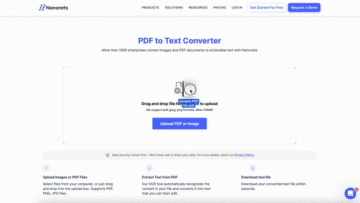
The modern business landscape is characterized by an overwhelming amount of information and documents that organizations must contend with. The global production, capture, copying, and consumption of data from various documents has been experiencing exponential growth. In 2020, the total data generated reached an estimated 64.2 zettabytes. Projections suggest that this trend will continue, with global data creation projected to exceed 180 zettabytes by 2025.
The costs and complexities associated with record-keeping have long been a challenge for businesses, with heavily-regulated industries facing an even greater burden. The emergence of electronic documents has helped solve issues related to physical storage, access, and retrieval. However, careful planning is necessary to prevent the loss or inaccessibility of electronic documents. Fortunately, advanced document workflow software has been developed to handle electronic documents throughout their lifecycle.
Document workflow management procedures exist in most companies, but their formality varies. They guide the storage, sharing, deletion, editing, categorization, and overall management of documents in a methodical and logical order. It covers important aspects such as document creation, retrieval, requests and approvals, file sharing, tracking and reporting, and document removal.
This article explores the significance of document workflow management and highlights key components of an effective workflow. By understanding the benefits and best practices, organizations can optimize their processes, enhance productivity, and ensure seamless access to critical information.
What is document workflow management?
Document workflow management is a system used to capture, generate, track, edit, approve, store, retrieve, retain, and destroy documents associated with business processes. Its importance lies in reducing paperwork, improving operational efficiency, reducing costs, productivity, and enhancing both employee and customer satisfaction. Documents such as purchase orders, invoices, holiday requests, proof of delivery, payroll, and more are passed between departments, requiring approval or changes at each stage, and the management of document workflow is of utmost importance to the smooth functioning of the company.
Document workflow management encompasses several key stages of document processing:
- Document creation: Generating new documents like reports, proposals, and contracts.
- Review and approval: Conduct thorough reviews, assigning tasks, sharing feedback, and managing version control.
- Distribution: Distributing approved documents to relevant stakeholders, including team members, partners, and customers.
- Storage: Securely storing documents in an organized and easily accessible manner, typically within a document management system.
There are two main types of document workflows: sequential and parallel. In sequential workflows, documents undergo a step-by-step review and approval process involving a single approver at each stage. Parallel workflows, on the other hand, involve multiple approvers simultaneously, allowing for collaborative feedback without waiting for individual approvals.
Document workflows can vary significantly across departments within an organization. The implementation of a document workflow management system helps model, control, monitor, and optimize these workflows and their individual steps. A robust document workflow software continuously analyzes the workflows to ensure efficiency and effectiveness
. Choosing the appropriate workflow type depends on factors such as the complexity of the review process and the timeline for completion.
Document workflow management is imperative in almost all industries, some of them being:
- HR Document Management: With document workflow software, HR departments can efficiently handle resumes, employment agreements, and other employee-related documents. These solutions provide secure repositories, strict access controls, compliance monitoring, and streamlined task management.
- Accounts Payable Document Management: Manual invoice handling can lead to delays and damaged relationships. Document workflow management solutions automate the accounts payable workflow, ensuring efficient routing, centralized storage, easy tracking, and timely payment processing.
- Contract Management: Complex contract management becomes more efficient with document workflow software. They provide centralized document handling, version control, personalized notifications, and streamlined review and approval processes, reducing manual efforts and minimizing errors.
- Asset Management: Document workflow management software are not limited to digital records. They serve as ideal solutions for tracking physical assets, such as hardware, vehicle fleets, or serial numbers, and provide reminders for inspections or reviews. Our clients utilize document workflow software to track diverse items, ranging from passwords and seed planting schedules to lab testing.
- Healthcare Record Management: Document workflow automation plays a crucial role in the healthcare industry, known for its heavy reliance on documentation. With the rising demand to streamline processes and reduce paper-related costs, healthcare leaders are actively seeking innovative solutions for workflow automation. The exponential growth of documents in healthcare leads to challenges such as reimbursement delays, lost documents, HIPAA compliance risks, inefficient use of file rooms, and additional expenses for copying, faxing, and couriers. Implementing document workflow automation addresses these issues by digitizing and automating document-related tasks. It eliminates manual handling, reduces errors, ensures compliance with HIPAA regulations, and improves operational efficiency. By embracing document workflow automation, healthcare organizations can improve patient care, enhance productivity, and allocate resources more effectively.
- Financial Data Management: Document workflow automation is essential in industries such as banking, insurance, and other fin-organizations. Without efficient document workflow management, handling enterprise documents becomes burdensome, leading to low employee morale and productivity. These industries face challenges in areas such as KYC documentation, customer onboarding, loan processing, and handling customer documents. Automating these processes improves efficiency, reduces manual effort, and enhances team productivity.
Benefits of document workflow management
Implementing a document workflow management system offers numerous benefits for businesses. By evaluating your current document storage and access methods, considering the potential risks and consequences of mishandling documents, and recognizing the advantages of efficient document management, you can determine if document workflow management is the right solution for your organization. From streamlining processes and improving efficiency to enhancing security, compliance, collaboration, and disaster recovery, document workflow management can revolutionize how your business handles its documents.
Here are the top benefits of adopting a document workflow management system for your business:
- Reduced Storage Space: An electronic document workflow management system eliminates the need for physical storage, reducing costs associated with file cabinets and storage bins. Documents can be stored digitally, freeing up valuable office space or utilizing less expensive offsite storage options.
- Enhanced Security: Document workflow management provides better control over sensitive documents, allowing access to be managed at a granular level. Audit trails track document views, access times, and modifications, improving document security. Managed documents can also be tagged for automated alerts.
- Improved Regulatory Compliance: Compliance requirements can be complex, but document workflow management reduces the risk of non-compliance. Automated records retention schedules and easier classification and storage of documents help meet strict security and privacy guidelines.
- Easier Document Retrieval: Searching for and retrieving documents is time-consuming and costly. A good document workflow management tool enables quick and efficient document retrieval, reducing labor costs associated with searching, filing, and reproducing lost documents. Integration with business applications enhances access to critical information, and remote document access is possible with an internet connection.
- Better Collaboration: Advanced document workflow management solutions facilitate easy access to documents and data and foster collaboration. Documents from different sources can be accessed from multiple locations, enabling seamless sharing over networks or via email. The management solution provides visibility into business processes and supports workflow monitoring. Authorized external user access can be granted and monitored.
- Efficient Task Allocation: Through the use of substitution rules, specific tasks can be automatically assigned to groups of individuals based on their availability and capacity. This enables smooth task allocation and ensures that workflows progress seamlessly even in the absence of specific employees. Managers can also closely monitor the progress of document workflows, ensuring timely completion and adherence to established processes. Document workflow management systems empower organizations to streamline their document-related processes and enhance overall productivity.
- Better Backup and Disaster Recovery: Document workflow management solutions often include document and data backup and disaster recovery plans, and protect documents from physical disasters. Digital archiving ensures document safety, while document tracking capabilities reduce the likelihood of loss or misfiling.
- Increased Productivity: Document workflow management saves time and boosts productivity. Faster document retrieval improves staff morale and enhances client satisfaction. Scalability allows the system to adapt to changing business needs. Additionally, intangible benefits include flexibility, competitiveness, improved client relations, and peace of mind.
Automated document workflow management with Nanonets
Document workflow management software enables businesses to simplify content management and streamline their overall business processes. To stay competitive and boost productivity, partnering with a reliable managed service provider to adopt a cost-effective Enterprise Content Management solution with comprehensive document workflow management software is highly recommended. Such customized system enables businesses to optimize their processes, ensuring they remain competitive and profitable in today’s fast-paced business landscape.
Nanonets, an AI-enabled Optical Character Recognition (OCR) technology, offers businesses the opportunity to automate their document management workflows effectively. Through its advanced capabilities, Nanonets can revolutionize various aspects of document management, including:
- Recurring Activities: Nanonets simplify repetitive activities like data entry from documents by automating data capture and streamlining the capture process within the workflow. This frees up valuable time that can be dedicated to more productive tasks, improving overall efficiency.
- Customization: Nanonets allow users to create custom automation recipes to automate data extraction from any kind of document. This flexibility empowers organizations to tailor document workflow management software to their specific needs and optimize productivity.
- Document Classification: Nanonets can automatically classify incoming documents, such as invoices, purchase orders, contracts, and receipts, based on their content. This automated classification streamlines document organization enhances data extraction accuracy, and boosts overall efficiency.
- Access Control: With Nanonets, businesses can easily determine and enforce document access permissions. The system can route documents to the appropriate decision-makers while ensuring that sensitive information remains accessible only to authorized personnel. This helps maintain data security, confidentiality, and regulatory compliance.
- Notifications: Nanonets enable the notification of specific team members or clients whenever an action is completed. This ensures timely communication and keeps stakeholders informed about the progress of tasks and projects.
- Tagging: Users can easily tag team members, customers, and stakeholders based on conditional data within Nanonets. This feature helps in organizing and directing tasks to the relevant individuals, ensuring smooth collaboration and accountability.
- Efficient Filing System: Nanonets automates the process of renaming files based on their content and accurately stores them in designated folders or locations. This systematic approach enhances document organization, minimizes the risk of file loss, and optimizes document retrieval speed and accuracy.
- Enhanced Searchability: Nanonets extract relevant data from documents, even those with unstructured formats, making them easily searchable. This feature empowers businesses to quickly locate specific documents or information within their document repository, significantly reducing manual search efforts and saving valuable time.
By leveraging Nanonets’ capabilities, businesses can streamline their document management workflows, improve efficiency, and optimize their overall document handling processes.
FAQs
What is document workflow management?
Document workflow management refers to the systematic approach and tools used to streamline the creation, routing, tracking, and processing of documents within an organization. It involves defining and automating the sequential or parallel steps involved in document-based processes, such as creation, review, approval, distribution, and storage. Document workflow management aims to improve efficiency, accuracy, and collaboration by standardizing and automating document-related tasks. It often involves the use of document management systems, workflow software, and other technologies to facilitate the seamless flow of documents, ensure compliance with regulations, enhance productivity, and enable easy retrieval and tracking of information.
What does document workflow mean?
Document workflow refers to the sequence of steps and activities involved in the creation, review, approval, distribution, and storage of documents within an organization. It encompasses the processes and procedures followed to ensure efficient and effective handling of documents throughout their lifecycle. Document workflow defines the flow of information, tasks, and decision-making related to documents, specifying the order and dependencies of activities involved in document management. The goal of document workflow is to streamline and automate document-based processes, improving productivity, collaboration, accuracy, and compliance. It involves defining roles and responsibilities, establishing approval mechanisms, setting deadlines, and implementing technology solutions to facilitate the smooth and efficient movement of documents within an organization.
What are three basic workflow management practices?
Three basic workflow management practices are:
1. Process Mapping: Process mapping involves visually representing the steps, tasks, and activities involved in a workflow. It helps in understanding the sequence of actions, dependencies, and decision points within a process. By mapping out the workflow, organizations can identify bottlenecks, inefficiencies, and areas for improvement.
2. Standardization: Standardization involves establishing consistent and predefined procedures and guidelines for performing tasks within a workflow. It ensures that everyone involved follows the same set of rules and processes, leading to greater consistency, efficiency, and quality in work outcomes. Standardization helps reduce errors, confusion, and rework while promoting better collaboration and accountability.
3. Automation: Automation involves the use of technology and software to automate manual tasks, streamline processes, and eliminate repetitive or mundane activities. By automating workflow steps, organizations can save time, reduce errors, and improve productivity. Automation tools can help in task assignment, notifications, data entry, document routing, and integration with other systems, enabling faster and more efficient workflow execution.
These practices can enhance workflow management by promoting clarity, consistency, and efficiency in work processes, ultimately leading to improved productivity and better outcomes.
What are the steps of document management?
Managing documents effectively requires a systematic approach. Here are the seven essential steps for implementing an efficient document management strategy:
- Team Formation: Assemble a dedicated team with representatives from various departments to oversee the document management process.
- Evaluation of Existing System: Assess the current filing and organizational practices for both physical and digital documents. Analyze how documents are received, stored, updated, and disposed of within the organization. Conduct a thorough investigation of a chosen department’s document-handling process to determine a standardized strategy.
- Document Identification: Take stock of the different types of documents, such as records, personal files, customer information, forms, and copies. Identify the documents that require frequent access and immediate availability.
- Requirements and Procedures: Define the storage and handling requirements for documents, considering whether a centralized or decentralized approach is appropriate. Determine the preferred document management system, such as physical filing or web-based solutions, or a combination of both.
- Strategy Development: Create a comprehensive plan outlining the step-by-step process for document management, including receiving, reviewing, processing, and retrieval. Decide whether the strategy will be applied uniformly across the organization or tailored to specific departments. Establish guidelines for document removal or deletion.
- Elimination of Redundant Documents: Streamline the document collection by removing unnecessary files, reducing clutter, and optimizing storage space. Consider creating an archive for older documents that may be required for future reference.
- Implementation and Maintenance: Put the document management strategy into action by transferring files to the designated system. Provide training to employees on proper document filing procedures to ensure compliance with established protocols and efficient system performance.
- SEO Powered Content & PR Distribution. Get Amplified Today.
- PlatoData.Network Vertical Generative Ai. Empower Yourself. Access Here.
- PlatoAiStream. Web3 Intelligence. Knowledge Amplified. Access Here.
- PlatoESG. Automotive / EVs, Carbon, CleanTech, Energy, Environment, Solar, Waste Management. Access Here.
- BlockOffsets. Modernizing Environmental Offset Ownership. Access Here.
- Source: https://nanonets.com/blog/document-workflow-management/
- :has
- :is
- :not
- $UP
- 12
- 14
- 15%
- 180
- 2020
- 2025
- 24
- 25
- 27
- 33
- 49
- 50
- 7
- 75
- a
- About
- access
- accessed
- accessible
- accountability
- Accounts
- accounts payable
- accuracy
- accurately
- across
- Action
- actions
- actively
- activities
- adapt
- Additional
- Additionally
- addresses
- adopt
- Adopting
- advanced
- advantages
- agreements
- aims
- Alerts
- All
- allocate
- allocation
- allow
- Allowing
- allows
- also
- amount
- an
- analyze
- analyzes
- and
- any
- applications
- applied
- approach
- appropriate
- approval
- approvals
- approve
- approved
- Archive
- ARE
- areas
- article
- AS
- aspects
- assess
- Assets
- assigned
- associated
- At
- audit
- authorized
- automate
- Automated
- automates
- automatically
- automating
- Automation
- availability
- Backup
- Banking
- based
- basic
- BE
- becomes
- been
- being
- benefits
- BEST
- best practices
- Better
- between
- boost
- boosts
- both
- bottlenecks
- burden
- business
- Business Applications
- business processes
- businesses
- but
- by
- CAN
- capabilities
- Capacity
- capture
- care
- careful
- centralized
- challenge
- challenges
- Changes
- changing
- character
- character recognition
- characterized
- choosing
- chosen
- clarity
- classification
- Classify
- client
- clients
- Close
- closely
- clutter
- collaboration
- collaborative
- collection
- COM
- combination
- Communication
- Companies
- company
- competitive
- competitiveness
- Completed
- completion
- complex
- complexities
- complexity
- compliance
- components
- comprehensive
- conditional
- Conduct
- confidentiality
- confusion
- connection
- Consequences
- Consider
- considering
- consistent
- consumption
- content
- content management
- continue
- continuously
- contract
- contract management
- contracts
- control
- controls
- copies
- copying
- cost-effective
- costly
- Costs
- covers
- create
- Creating
- creation
- critical
- crucial
- Current
- custom
- customer
- customer information
- Customer satisfaction
- Customers
- customized
- data
- data entry
- data management
- data security
- decentralized
- decide
- decision
- Decision Making
- decision-makers
- dedicated
- define
- Defines
- defining
- delays
- delivery
- Demand
- Department
- departments
- depends
- designated
- destroy
- Determine
- developed
- Development
- different
- digital
- digital documents
- digitally
- digitizing
- directing
- disaster
- disasters
- distributing
- distribution
- diverse
- document
- document management
- documentation
- documents
- does
- each
- easier
- easily
- easy
- Effective
- effectively
- efficiency
- efficient
- efficiently
- effort
- efforts
- Electronic
- eliminate
- eliminates
- embracing
- emergence
- Employee
- employees
- employment
- empower
- empowers
- enable
- enables
- enabling
- encompasses
- enforce
- enhance
- Enhances
- enhancing
- ensure
- ensures
- ensuring
- Enterprise
- entry
- Errors
- essential
- establish
- established
- establishing
- estimated
- evaluating
- Even
- everyone
- exceed
- execution
- exist
- existing
- existing system
- expenses
- expensive
- experiencing
- explores
- exponential
- Exponential Growth
- external
- extract
- extraction
- Face
- facilitate
- facing
- factors
- fast-paced
- faster
- Feature
- feedback
- File
- Files
- Filing
- Flexibility
- flow
- followed
- follows
- For
- formation
- forms
- Fortunately
- Foster
- frequent
- from
- functioning
- future
- generate
- generated
- Global
- goal
- good
- granted
- greater
- Group’s
- Growth
- guide
- guidelines
- hand
- handle
- Handles
- Handling
- Hardware
- Have
- healthcare
- healthcare industry
- heavy
- help
- helped
- helps
- here
- highlights
- highly
- Holiday
- How
- However
- hr
- HTTPS
- ideal
- Identification
- identify
- if
- immediate
- imperative
- implementation
- implementing
- importance
- important
- improve
- improved
- improvement
- improves
- improving
- in
- include
- Including
- Incoming
- individual
- individuals
- industries
- industry
- inefficient
- information
- informed
- innovative
- insurance
- integration
- Internet
- internet connection
- into
- investigation
- involve
- involved
- involves
- involving
- issues
- IT
- items
- ITS
- Key
- Kind
- known
- KYC
- lab
- Lab Testing
- labor
- landscape
- lead
- leaders
- leading
- Leads
- less
- Level
- leveraging
- lies
- lifecycle
- like
- likelihood
- Limited
- loan
- locations
- logical
- Long
- loss
- lost
- Low
- Main
- maintain
- maintenance
- Making
- managed
- management
- management software
- Management Solution
- management system
- Managers
- managing
- manner
- manual
- mapping
- May..
- mean
- mechanisms
- Meet
- Members
- methodical
- methods
- mind
- minimizing
- mishandling
- model
- Modern
- Modifications
- Monitor
- monitored
- monitoring
- more
- more efficient
- most
- movement
- multiple
- must
- necessary
- Need
- needs
- networks
- New
- notification
- notifications
- numbers
- numerous
- numerous benefits
- OCR
- of
- Offers
- Office
- often
- older
- on
- Onboarding
- only
- operational
- Opportunity
- optical
- optical character recognition
- Optimize
- Optimizes
- optimizing
- Options
- or
- order
- orders
- organization
- organizational
- organizations
- Organized
- organizing
- Other
- our
- out
- outcomes
- over
- overall
- oversee
- paperwork
- Parallel
- partnering
- partners
- passed
- Passwords
- patient
- patient care
- payment
- payment processing
- Payroll
- peace
- performance
- performing
- permissions
- personal
- Personalized
- Personnel
- physical
- plan
- planning
- plans
- Planting
- plato
- Plato Data Intelligence
- PlatoData
- plays
- points
- possible
- potential
- practices
- preferred
- prevent
- privacy
- procedures
- process
- processes
- processing
- Production
- productive
- productivity
- profitable
- Progress
- projected
- projections
- projects
- promoting
- proof
- proper
- Proposals
- protect
- protocols
- provide
- provider
- provides
- purchase
- put
- quality
- Quick
- quickly
- ranging
- reached
- receipts
- received
- receiving
- Recipes
- recognition
- recognizing
- recommended
- record
- record-keeping
- records
- recovery
- reduce
- reduces
- reducing
- reference
- refers
- regular
- regulations
- regulatory
- Regulatory Compliance
- reimbursement
- related
- relations
- Relationships
- relevant
- reliable
- reliance
- remain
- remains
- remote
- removal
- removing
- repetitive
- Reporting
- Reports
- repository
- Representatives
- representing
- requests
- require
- required
- Requirements
- requires
- Resources
- responsibilities
- retain
- retention
- review
- reviewing
- Reviews
- revolutionize
- right
- rising
- Risk
- risks
- robust
- Role
- roles
- Rooms
- Route
- routing
- rules
- s
- Safety
- same
- satisfaction
- Save
- saving
- Scalability
- seamless
- seamlessly
- Search
- searching
- secure
- security
- seed
- seeking
- sensitive
- Sequence
- serial
- serve
- service
- Service Provider
- set
- setting
- seven
- several
- sharing
- significance
- significantly
- simplify
- simultaneously
- single
- smooth
- Software
- solution
- Solutions
- SOLVE
- some
- Sources
- Space
- specific
- speed
- Staff
- Stage
- stages
- stakeholders
- standardizing
- stay
- Steps
- stock
- storage
- storage options
- store
- stored
- stores
- Strategy
- streamline
- streamlined
- streamlining
- strict
- such
- suggest
- Supports
- system
- Systems
- TAG
- tailored
- Take
- Task
- tasks
- team
- Team members
- Technologies
- Technology
- Testing
- that
- The
- their
- Them
- These
- they
- this
- those
- three
- Through
- throughout
- time
- time-consuming
- timeline
- times
- to
- today
- tool
- tools
- top
- Total
- track
- Tracking
- Training
- Transferring
- Trend
- two
- type
- types
- typically
- Ultimately
- undergo
- understanding
- unnecessary
- updated
- use
- used
- User
- users
- utilize
- Utilizing
- Valuable
- various
- vehicle
- version
- version control
- via
- views
- visibility
- Waiting
- web-based
- What
- What is
- whenever
- whether
- while
- will
- with
- within
- without
- Work
- workflow
- workflow automation
- workflows
- you
- Your
- zephyrnet











